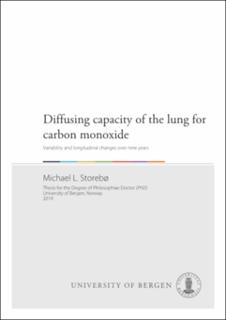| dc.contributor.author | Storebø, Michael Langballe | en_US |
| dc.date.accessioned | 2019-04-09T07:34:53Z | |
| dc.date.available | 2019-04-09T07:34:53Z | |
| dc.date.issued | 2019-03-13 | |
| dc.identifier.isbn | 978-82-308-3540-1 | en_US |
| dc.identifier.uri | https://hdl.handle.net/1956/19301 | |
| dc.description.abstract | Pulmonary gas exchange oxygenates our blood and facilitates transfer of carbon dioxide produced out of the body. Measurement of pulmonary gas exchange by diffusing capacity of the lung for carbon monoxide (DLCO) shows a relatively large variability compared to other lung function measurements. DLCO is reduced by about 10 % in male test subjects 2-6 hours after exercise, which can contribute to measurement variability if it is not taken into consideration. The mechanisms behind post-exercise reduction in DLCO are not fully understood. We hypothesized that cutaneous vasodilation due to thermoregulation contributes to reducing pulmonary capillary blood volume after exercise, and thus reduction in DLCO due to less haemoglobin being able to bind oxygen in the lung. 12 subjects, 6 women, went through an experimental protocol of baseline measurements of DLCO, mean surface temperature and cutaneous vascular conductance, and then a bout of exercise on a stationary bike to exhaustion. DLCOmeasurements were repeated after 90 minutes. They were then exposed to cold air to induce vasoconstriction, after which measurements were repeated. The participants acted as their own controls by going through the entire experiment except the cold exposure, on a different day. DLCO was reduced by 10% in the men, and 5% in the women, 90 minutes postexercise. Mean surface temperature and cutaneous vascular conductance were at the same level as at baseline. Exposure to cold air induced a cutaneous vasoconstriction, but DLCO remained at the same level. Post-exercise cutaneous hemodynamics and thermoregulation does not seem to contribute to the reduction in DLCO in the late recovery phase after exercise. In addition to challenges due to the relatively large measurement variability, little is known about the normal trajectory of DLCO-values throughout life, what causes change in DLCO over time, and what impact change in DLCO has on respiratory symptoms. We wanted to model the change in DLCO over time in a general population sample and investigate possible predictors of different trajectories and we wanted to investigate whether the change in DLCO has any impact on dyspnoea in a general population sample. 830 participants in the Hordaland County Cohort Study provided two measurements of DLCO and forced spirometry 9 years apart. Blood samples were analysed for haemoglobin and carboxyhaemoglobin. We also recorded age, height, weight, smoking status, accumulated tobacco smoke exposure, occupational exposure to dust and gas, education level and level of dyspnoea. Mean change in DLCO was -0.025 mmol ∙ min-1 ∙ kPa-1 ∙ year-1. We found that the decline accelerated with higher age. Smoking was a predictor for a more rapid decline in DLCO, and there was a dose-response-relationship between accumulated tobacco smoke exposure and rate of decline in DLCO. The decline in DLCO was associated with an increase in dyspnoea score in men. We found no such association for women. An interaction between age and change in DLCO was observed in both men and women, with a more severe increase in dyspnoea per unit of decline in DLCO with higher age. In a general population sample observed over 9 years, the rate of decline in DLCO accelerated with higher age. Smoking was associated with a more rapid decline. An association between decline in DLCO and increase in dyspnoea was observed in the men, but not in the women. | en_US |
| dc.language.iso | eng | eng |
| dc.publisher | The University of Bergen | eng |
| dc.relation.haspart | Paper I: Storebo ML, Hope A, Vaagbo G, Thorsen E. Postexercise reduction in lung diffusion capacity is not attenuated by skin cooling. Clin Physiol Funct Imaging. 2008;28(6):403-8. The article is available in the main thesis. The article is also available at: <a href="https://doi.org/10.1111/j.1475-097X.2008.00821.x" target="blank">https://doi.org/10.1111/j.1475-097X.2008.00821.x</a> | en_US |
| dc.relation.haspart | Paper II: Storebo ML, Eagan TM, Eide GE, Gulsvik A, Thorsen E, Bakke PS. Change in pulmonary diffusion capacity in a general population sample over 9 years. Eur Clin Respir J. 2016;3:31265. The article is available at: <a href="http://hdl.handle.net/1956/19300" target="blank">http://hdl.handle.net/1956/19300</a> | en_US |
| dc.relation.haspart | Paper III: Storebo ML, Eagan TM, Eide GE, Gulsvik A, Thorsen E, Bakke PS. Does change in gas diffusing capacity relate to change in dyspnoea score independently of spirometry? The article is not available in BORA. | en_US |
| dc.title | Diffusing capacity of the lung for carbon monoxide. Variability and longitudinal changes over nine years | en_US |
| dc.type | Doctoral thesis | |
| dc.rights.holder | Copyright the author. All rights reserved | |
| dc.identifier.cristin | 1684697 | |
